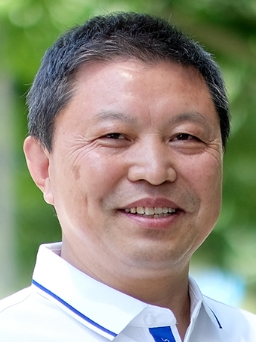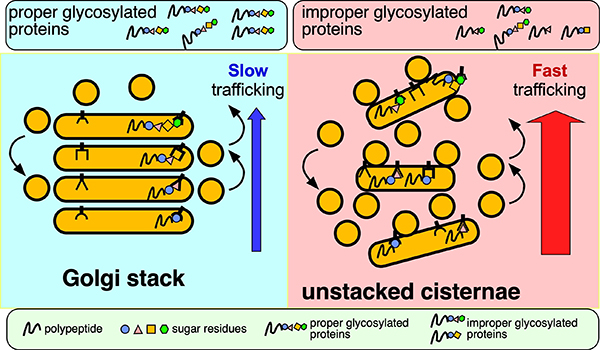
Senior Principal Investigator
Neurobiology
yzwang@szbl.ac.cn
Golgi biogenesis, function, and defects in diseases.
Dr. Wang's research focuses on Golgi biology, spanning across multiple disciplines including cell biology, biochemistry, molecular biology, neuroscience, and endocrinology. The Golgi apparatus is a crucial membranous organelle within the secretory pathway of cells, responsible for the transportation and processing of diverse proteins. A distinctive feature of this organelle is its stacked arrangement of flattened cisternae, which undergoes rapid disassembly and reassembly under physiological or stress conditions. As a senior scientist in the field of Golgi research, Dr. Wang has made significant contributions to understanding the molecular mechanisms underlying Golgi structure formation and function, as well as the mechanisms and therapeutic strategies for diseases caused by Golgi defects.
Key accomplishments include:
1. Molecular mechanisms of Golgi structure formation and function: Through years of experimentation and exploration utilizing multidisciplinary approaches such as biochemistry, cell biology, electron microscopy, in vitro reconstitution, proteomics, and glycomics, Dr. Wang elucidated the molecular mechanisms underlying Golgi structural formation, function, and defects under stress and disease conditions.
Specific findings include:
1) Elucidated the mechanisms and functions of multi-layered stack formation of Golgi membranes, including the crucial roles of Golgi structure proteins GRASP65 and GRASP55 in Golgi stacking formation, as well as the regulation of protein transport speed, glycosylation, and sorting by Golgi stacking. (Figure 1)

Figure 1. Golgi unstacking accelerates protein trafficking but impairs accurate glycosylation and sorting.
In the stack (A), vesicles can form and fuse only at the rims. This slows down trafficking but enforces accurate glycosylation. When cisternae are unstacked (B), more membrane area becomes accessible, thereby increasing cargo transport. This, however, causes glycosylation and sorting defects.
2) Revealed the molecular mechanisms of Golgi biogenesis during cell division, including the regulation of Golgi biogenesis by phosphorylation and monoubiquitination. (Figure 2)

Figure 2. Ubiquitin regulates post-mitotic Golgi membrane fusion.
Mitotic Golgi disassembly is mediated by cisternal unstacking and vesiculation. p97-mediated post-mitotic membrane fusion requires ubiquitination of syntaxin 5 (Syn5) by HACE1 in early mitosis and deubiquitination by VCIP135 at the end of mitosis.
3) Explored the molecular mechanisms of Golgi stress response, including the adaptation of Golgi structure to various stress conditions such as oxidative stress, endoplasmic reticulum stress, and nutrient deprivation.
2. Mechanisms and therapeutic strategies for diseases caused by Golgi defects:Dr. Wang is committed to translating scientific research into practical applications. He has conducted extensive experiments on the structural and functional changes of the Golgi in various diseases, designed novel diagnostic methods for Alzheimer's disease, initiated the development of therapeutic drugs, and explored new directions for the diagnosis and treatment of various challenging diseases.
Specific achievements include:
1) Determined Golgi defects and their implications in human diseases. In Alzheimer's disease, Dr. Wang discovered that Aβ accumulation activates Cdk5, leading to the phosphorylation and inactivation of GRASP65, ultimately resulting in Golgi fragmentation. Significantly, rescuing Golgi structural defects reduces Aβ secretion by promoting non-amyloidogenic cleavage of the amyloid precursor protein (APP) (Figure 3). He also found that GRASP55 regulates unconventional secretion and aggregation of neurotoxic proteins such as mutant Huntingtin. In COVID-19, Dr. Wang found that SARS-CoV-2 infection modulates the Golgi structure by down-regulating GRASP55 expression to facilitate viral assembly, trafficking, and release. He is actively applying a similar approach to investigate Golgi defects in diverse diseases, including asthma, diabetes, and cancer.

Figure 3. Potential mechanism of Golgi fragmentation in AD.
Aβ accumulation leads to Ca2+ influx (1), increased cytosolic Ca2+ activates calpain (2) that cleaves p35 to p25 (3). p25 activates cdk5 for tau (4) and GRASP65 (5) phosphorylation, resulting in Golgi fragmentation (6), which in turn accelerates APP trafficking and increases Aβ production, and impact trafficking and processing of other neuronal proteins (7).
2) Developed diagnostic and therapeutic approaches targeting Golgi defects for Alzheimer's disease. In collaboration with partners, Dr. Wang co-founded Camillo Therapeutics, a biotechnology company aimed at advancing diagnostic and therapeutic solutions for Alzheimer's disease. He developed a cell-based high-throughput screening method and cutting-edge therapeutic compounds targeting Golgi defects associated with Alzheimer's. Additionally, he devised an early diagnostic experimental approach with the overarching objective of integrating diagnosis and treatment strategies.
Dr. Wang has published over 100 papers in journals such as Nat Comm, Nat Protoc, Dev Cell, PNAS, Cell Rep, JCB, JBC, JCI, JACS, EMBO J, MBoC, JCS, Autophagy, Trends Biochem Sci, Trends Cell Biol, and Cold Spring Harb Perspect Biol, and has authored two books and contributed 20 book chapters. His research has been commented by peers and reported by news media.
2024-present Shenzhen Bay Laboratory Senior Principal Investigator
2021-2024 Camillo Therapeutics, Inc. Co-Founder
2014-2017 University of Michigan Associate Chair for Research and Facilities
2005-2024 University of Michigan Assistant Professor, Associate Professor, Professor
1999-2005 Yale University Postdoctoral Associate, Associate Research Scientist
1994-1999 Heidelberg University Ph.D. in Neurobiology
1987-1990 Nankai University B.S. in Zoology, M.S. in Cell Biology, Lecturer
2022 New Therapeutic Innovation Award, University of Michigan
2019 Title of Most Eloquent Reviewer, ACS Cell Structure and Metastasis study section
2014-2015 Research Scholar, Mizutani Foundation for Glycoscience
2014 “Novel & Newsworthy” Top News Pick, the ASCB 2014 annual meeting
2009-2014 Research Scholar, American Cancer Society (ACS)
1999 First Prize for the best scientific discovery in the Department of Neurobiology, University of Heidelberg, Germany
1995 Best scientific contribution, Natural Science Foundation of China
1993 Teaching Award, Nankai University, China
1990 Outstanding thesis award, Nankai University, China
1. Huang S, Haga Y, Li J, Zhang J, Kweon HK, Seino J, Hirayama H, Fujita M, Moremen KW, Andrews P, Suzuki T, Wang Y#. Mitotic phosphorylation inhibits the Golgi mannosidase MAN1A1. Cell Rep.2022 Nov 22;41(8):111679. doi: 10.1016/j.celrep.2022.111679.
2.Ahat E, Bui S, Zhang J, da Veiga Leprevost F, Sharkey L, Reid W, Nesvizhskii AI, Paulson HL, Wang Y#. GRASP55 regulates the unconventional secretion and aggregation of mutant huntingtin. J Biol Chem.2022 Aug;298(8):102219. doi: 10.1016/j.jbc.2022.102219. Epub 2022 Jul 1.
3.Zhang X, Wang Y#. Nonredundant Roles of GRASP55 and GRASP65 in the Golgi Apparatus and Beyond. Trends Biochem Sci. 2020 Dec;45(12):1065-1079. doi: 10.1016/j.tibs.2020.08.001. Epub2020 Sep 4.
4.Zhang X, Wang L, Ireland SC, Ahat E, Li J, Bekier ME 2nd, Zhang Z, Wang Y#. GORASP2/GRASP55 collaborates with the PtdIns3K UVRAG complex to facilitate autophagosome-lysosome fusion. Autophagy.2019 Oct;15(10):1787-1800. doi: 10.1080/15548627.2019.1596480.
5.Zhang X, Wang L, Lak B, Li J, Jokitalo E, Wang Y#. GRASP55 Senses Glucose Deprivation through O-GlcNAcylation to Promote Autophagosome-Lysosome Fusion. Dev Cell.2018 Apr 23;45(2):245-261.e6. doi: 10.1016/j.devcel.2018.03.023.
6.Huang S, Tang D, Wang Y#. Monoubiquitination of Syntaxin 5 Regulates Golgi Membrane Dynamics during the Cell Cycle. Dev Cell.2016 Jul 11;38(1):73-85. doi: 10.1016/j.devcel.2016.06.001.
7.Joshi G, Chi Y, Huang Z, Wang Y#. Aβ-induced Golgi fragmentation in Alzheimer's disease enhances Aβ production. Proc Natl Acad Sci U S A.2014 Apr 1;111(13):E1230-9. doi: 10.1073/pnas.1320192111.
8.Tang D, Wang Y#. Cell cycle regulation of Golgi membrane dynamics. Trends Cell Biol. 2013 Jun;23(6):296-304. doi: 10.1016/j.tcb.2013.01.008. Epub2013 Feb 28.
9.Xiang Y, Zhang X, Nix DB, Katoh T, Aoki K, Tiemeyer M, Wang Y#. Regulation of protein glycosylation and sorting by the Golgi matrix proteins GRASP55/65. Nat Commun.2013;4:1659. doi: 10.1038/ncomms2669.
10.Tang D, Xiang Y, Wang Y#. Reconstitution of the cell cycle-regulated Golgi disassembly and reassembly in a cell-free system. Nat Protoc.2010 Apr;5(4):758-72. doi: 10.1038/nprot.2010.38.
11.Tang D, Xiang Y, De Renzis S, Rink J, Zheng G, Zerial M, Wang Y#. The ubiquitin ligase HACE1 regulates Golgi membrane dynamics during the cell cycle. Nat Commun.2011 Oct 11;2:501. doi: 10.1038/ncomms1509.
12.Xiang Y, Wang Y#. GRASP55 and GRASP65 play complementary and essential roles in Golgi cisternal stacking. J Cell Biol.2010 Jan 25;188(2):237-51. doi: 10.1083/jcb.200907132.